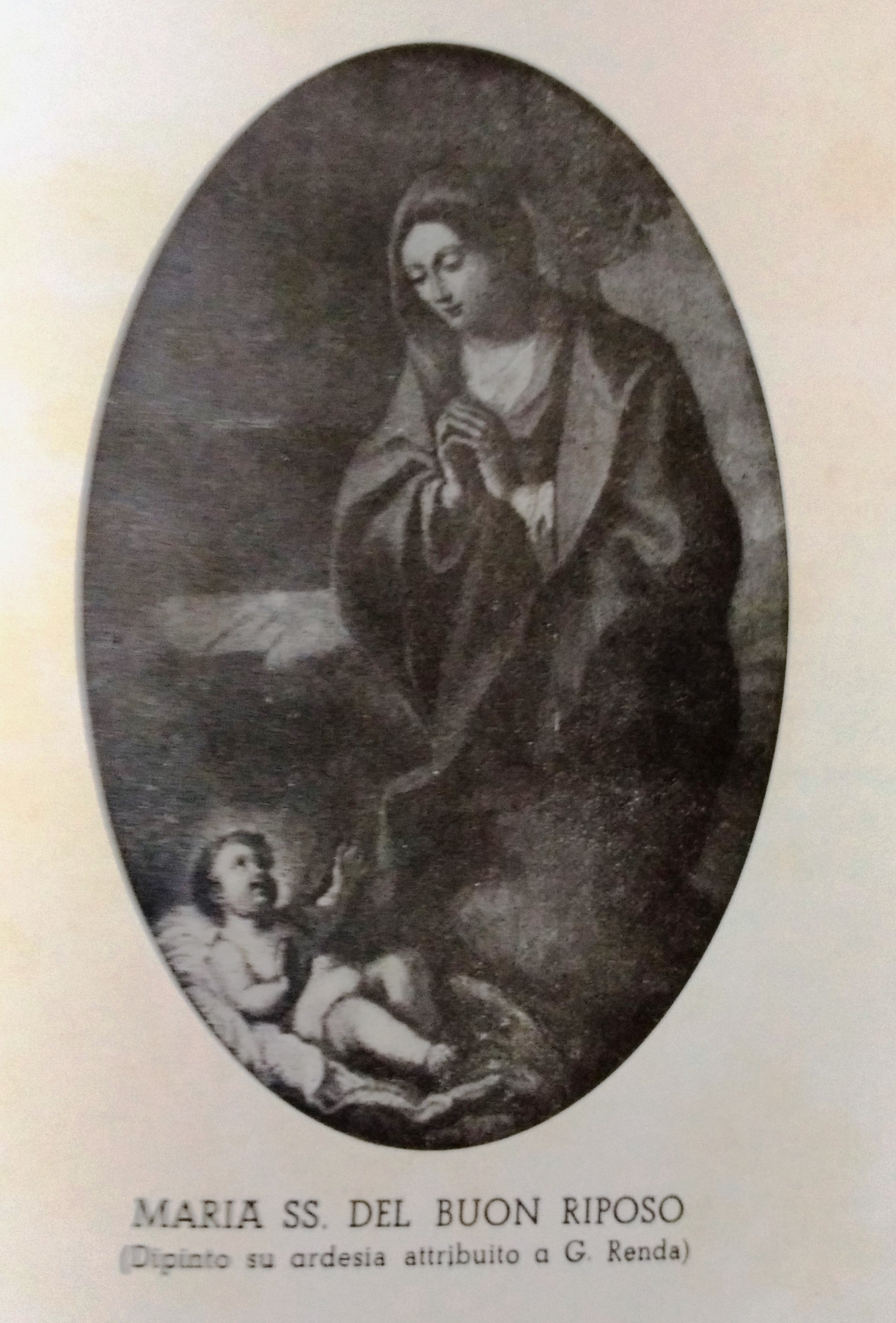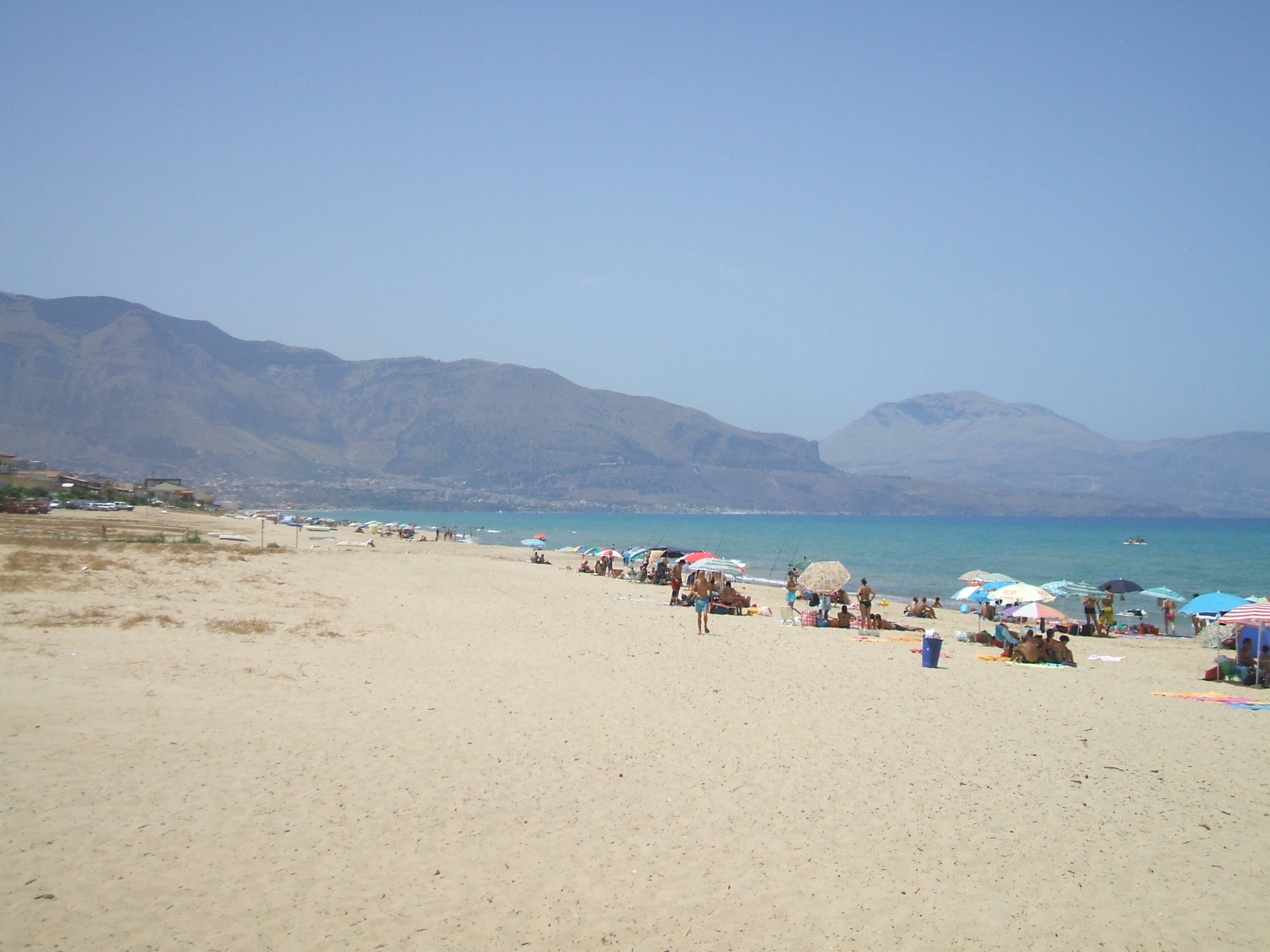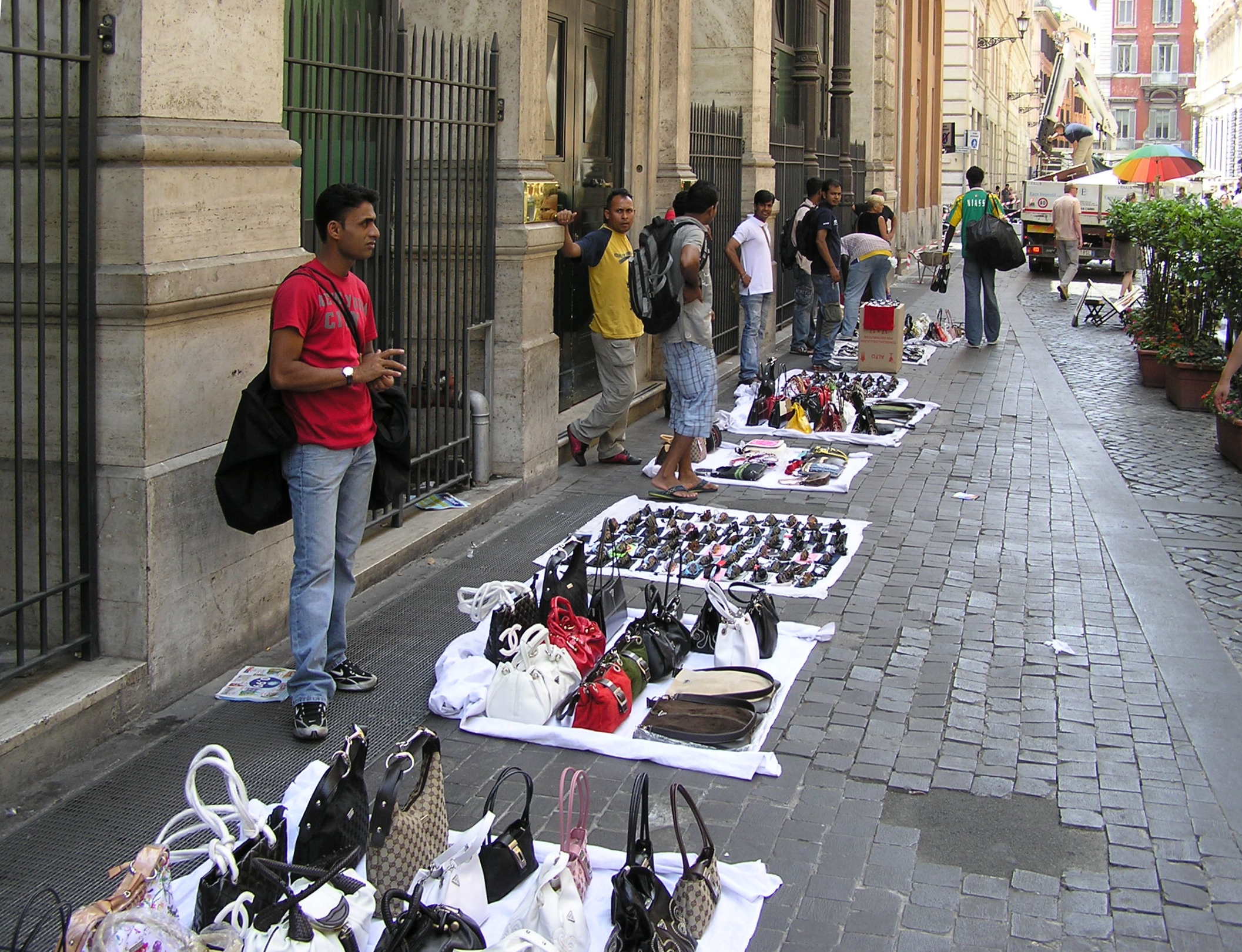|
Church Of Madonna Del Riposo (Alcamo)
Madonna del Riposo ("Our Lady of the Rest") is a Catholic church located in Alcamo, in the province of Trapani. History In 1656 in the district called "Madonna del Riposo", at the foot of Mount Bonifato, they built a little Church in honour of the Madonna with the same title. The strip of land needed for its construction was donated by doctor Diego Nicodemi, and there are two notarial deeds, drawn up by the notary La Perna which attest the details; the land should have been about five metres and half long and four metres large.Cataldo Carlo: Accanto alle aquile: Il castello alcamese di Bonifato e la chiesa di S. Maria dell'Alto p.98-101; Brotto, Palermo,1991 This piece of land was located in the feud of Costa and in ''contrada the pusaturi''. In 1939 the building was restored thanks to the offerings of the believers and the Virgilio family, the owner of this place, donated a painting on slate with the image of the Virgin Mary, assigned to Giuseppe Renda. They also made the e ... [...More Info...] [...Related Items...] OR: [Wikipedia] [Google] [Baidu] |
Alcamo
Alcamo (; scn, Àrcamu, italic=no) is the fourth-largest town and commune of the Province of Trapani, Sicily, with a population of 44.925 inhabitants. It is on the borderline with the Metropolitan City of Palermo at a distance of about 50 kilometres from Palermo and Trapani. Nowadays the town territory includes an area of 130,79 square kilometres and is the second municipality as for population density in the province of Trapani, after Erice. Alcamo is bounded by the Tyrrhenian Sea on the north, Balestrate and Partinico on the east, Camporeale on the south and Calatafimi-Segesta and Castellammare del Golfo on the west. Its most important hamlet is Alcamo Marina at about 6 kilometres from the town centre. Together with other municipalities it takes part in the ''Associazione Città del Vino'', the movement ''Patto dei Sindaci'', ''Progetto Città dei Bambini'', ''Rete dei Comuni Solidali'' and ''Patto Territoriale Golfo di Castellammare''. Geography Territory Alcamo is ... [...More Info...] [...Related Items...] OR: [Wikipedia] [Google] [Baidu] |
Sacristy
A sacristy, also known as a vestry or preparation room, is a room in Christian churches for the keeping of vestments (such as the alb and chasuble) and other church furnishings, sacred vessels, and parish records. The sacristy is usually located inside the church, but in some cases it is an annex or separate building (as in some monasteries). In most older churches, a sacristy is near a side altar, or more usually behind or on a side of the main altar. In newer churches the sacristy is often in another location, such as near the entrances to the church. Some churches have more than one sacristy, each of which will have a specific function. Often additional sacristies are used for maintaining the church and its items, such as candles and other materials. Description The sacristy is also where the priest and attendants vest and prepare before the service. They will return there at the end of the service to remove their vestments and put away any of the vessels used during the s ... [...More Info...] [...Related Items...] OR: [Wikipedia] [Google] [Baidu] |
Fireworks
Fireworks are a class of Explosive, low explosive Pyrotechnics, pyrotechnic devices used for aesthetic and entertainment purposes. They are most commonly used in fireworks displays (also called a fireworks show or pyrotechnics), combining a large number of devices in an outdoor setting. Such displays are the focal point of many cultural and religious Celebration (party), celebrations. Fireworks take many forms to produce four primary effects: noise, light, smoke, and floating materials (confetti most notably). They may be designed to burn with colored flames and sparks including red, orange, yellow, green, blue, purple and silver. They are generally classified by where they perform, either 'ground' or 'aerial'. Aerial fireworks may have their own Air propulsion, propulsion (skyrocket) or be shot into the air by a Mortar (weapon), mortar (aerial shell). Most fireworks consist of a paper or Card stock, pasteboard tube or casing filled with the combustion, combustible materia ... [...More Info...] [...Related Items...] OR: [Wikipedia] [Google] [Baidu] |
Street Vendors
A hawker is a vendor of merchandise that can be easily transported; the term is roughly synonymous with costermonger or peddler. In most places where the term is used, a hawker sells inexpensive goods, handicrafts, or food items. Whether stationary or mobile, hawkers often advertise by loud street cries or chants, and conduct banter with customers, to attract attention and enhance sales. Definition A hawker is a type of street vendor; “a person who travels from place-to-place selling goods.” Synonyms include huckster, peddler, chapman or in Britain, costermonger. However, hawkers are distinguished from other types of street vendors in that they are mobile. In contrast, peddlers, for example, may take up a temporary pitch in a public place. Similarly, hawkers tend to be associated with the sale of non-perishable items such as brushes and cookware while costermongers are exclusively associated with the sale of fresh produce. When accompanied by a demonstration or detailed expl ... [...More Info...] [...Related Items...] OR: [Wikipedia] [Google] [Baidu] |
Low Mass
Low Mass (Latin ''Missa lecta'', "read Mass") is a Tridentine Mass defined officially in the Code of Rubrics included in the 1962 edition of the Roman Missal as a Mass in which the priest does not chant the parts that the rubrics assign to him. A sung Mass celebrated with the assistance of sacred ministers (deacon and subdeacon) is a High or Solemn Mass; without them it is a '' Missa Cantata''. History Low Mass originated in the early Middle Ages as a shortened or simplified form of Solemn Mass. In the early church, as in the Orthodox church today, all services were chanted, and there was no equivalent to the Roman Low Mass or to the Anglican "said celebration". Masses without solemnity in early Christianity Alongside the public solemn Masses, the practice developed from the 4th century onwards, of smaller private Masses for smaller groups of believers. These masses were often celebrated in the catacombs, for the deceased or on a special anniversary. An example is provided by Sai ... [...More Info...] [...Related Items...] OR: [Wikipedia] [Google] [Baidu] |
Belice Earthquake
The 1968 Belice earthquake sequence took place in Sicily between 14 and 15 January. The largest shock measured 5.5 on the moment magnitude scale, with five others of magnitude 5+. The maximum perceived intensity was X (''Extreme'') on the Mercalli intensity scale. The earthquake sequence, centred between the towns of Gibellina, Salaparuta and Poggioreale, killed at least 231 people, possibly more than 400, with between 632 and about 1,000 injured and left 100,000 homeless. It is known in Italy as Terremoto del Belice. Tectonic setting Sicily lies on the complex convergent plate boundary between the African Plate and the Eurasian Plate. The geology of the western part of the island is dominated by the Gela Nappe, a thin-skinned fold and thrust belt. The Gela Nappe consists of Pliocene-Quaternary age sedimentary rocks deposited in the earlier foredeep, thrust up onto the thick carbonate sequence of the Pelagian-Hyblean Platform of the African Plate. Earthquake There was ... [...More Info...] [...Related Items...] OR: [Wikipedia] [Google] [Baidu] |
Parson
A parson is an ordained Christian person responsible for a small area, typically a parish. The term was formerly often used for some Anglican clergy and, more rarely, for ordained ministers in some other churches. It is no longer a formal term denoting a specific position within Anglicanism, but has some continued historical and colloquial use. In the pre-Reformation church, a parson was the priest of an independent parish church, that is, a church not under the control of a larger ecclesiastical or monastic organization. The term is similar to rector and is in contrast to a vicar, a cleric whose revenue is usually, at least partially, appropriated by a larger organisation. Today the term is normally used for some parish clergy of non-Roman Catholic churches, in particular in the Anglican tradition in which a parson is the incumbent of a parochial benefice: a parish priest or a rector; in this sense a parson can be compared with a vicar. The title ''parson'' can be applied to cle ... [...More Info...] [...Related Items...] OR: [Wikipedia] [Google] [Baidu] |
Ministry Of The Interior
An interior ministry (sometimes called a ministry of internal affairs or ministry of home affairs) is a government department that is responsible for internal affairs. Lists of current ministries of internal affairs Named "ministry" * Ministry of Internal Affairs (Adygea) * Ministry of Interior Affairs (Afghanistan) * Ministry of Internal Affairs (Albania) * Ministry of Internal Affairs (Altai Republic) * Ministry of the Interior (Argentina) * Ministry of the Interior (Austria) * Ministry of Internal Affairs (Azerbaijan) * Ministry of Interior (Bahrain) * Ministry of Home Affairs (Bangladesh) * Ministry of Public Administration (Bangladesh) * Ministry of Internal Affairs (Bashkortostan) * Ministry of Internal Affairs (Belarus) * Ministry of Home Affairs (Bermuda) * Ministry of Home and Cultural Affairs (Bhutan) * Federal Ministry of Interior (Federation of Bosnia and Herzegovina) * Ministry of National Integration (Brazil) * Ministry of Home Affairs (Brunei) * Ministry of Int ... [...More Info...] [...Related Items...] OR: [Wikipedia] [Google] [Baidu] |
Parish
A parish is a territorial entity in many Christian denominations, constituting a division within a diocese. A parish is under the pastoral care and clerical jurisdiction of a priest, often termed a parish priest, who might be assisted by one or more curates, and who operates from a parish church. Historically, a parish often covered the same geographical area as a manor. Its association with the parish church remains paramount. By extension the term ''parish'' refers not only to the territorial entity but to the people of its community or congregation as well as to church property within it. In England this church property was technically in ownership of the parish priest ''ex-officio'', vested in him on his institution to that parish. Etymology and use First attested in English in the late, 13th century, the word ''parish'' comes from the Old French ''paroisse'', in turn from la, paroecia, the latinisation of the grc, παροικία, paroikia, "sojourning in a foreign ... [...More Info...] [...Related Items...] OR: [Wikipedia] [Google] [Baidu] |
Bishop Of Trapani
The Italian Catholic diocese of Trapani is in Sicily. It is a suffragan of the archdiocese of Palermo. History Trapani was subject to the see of Mazzara, from the Norman Conquest until 1844, when the diocese was created. Its first bishop was the Redemptorist Vincenzo M. Marolda. Bishop Francesco Miccichè was removed on May 19, 2012 from the office of bishop of this diocese.Ad of 2021 the diocese Is held up by Pietro Maria Fragnelli, which in May 2015 has been appointed as responsible of the commission for family, life and youth within the Episcopal Conference of Italy. Ordinaries *Vincenzo Maria Marolda, C.SS.R. (1844–1851 Resigned) *Vincenzo Ciccolo Rinaldi (1853–1874 Died) *Giovanni Battista Bongiorni (1874–1879 Appointed, Bishop of Caltagirone) *Francesco Ragusa (1879–1895 Died) *Stefano Gerbino di Cannitello, O.S.B. (1895–1906 Resigned) *Francesco Maria Raiti, O. Carm. (1906–1932 Died) *Ferdinando Ricca (1932–1947 Died) *Filippo Jacolino (1947–1950 Died ... [...More Info...] [...Related Items...] OR: [Wikipedia] [Google] [Baidu] |
Vestments
Vestments are liturgical garments and articles associated primarily with the Christian religion, especially by Eastern Churches, Catholics (of all rites), Anglicans, and Lutherans. Many other groups also make use of liturgical garments; this was a point of controversy in the Protestant Reformation and sometimes since, in particular during the ritualist controversies in England in the 19th century. Origins of vestments In the early Christian churches, officers and leaders, like their congregations, wore the normal dress of civil life in the Greco-Roman world, although with an expectation that the clothing should be clean and pure during holy observances. From the 4th century onward, however, modifications began to be made to the form of the garments, and as secular fashions changed from the 6th century the church retained the original forms of their garments, although with separate development and with regional variations. Having separate, consecrated clothing for the ceremoni ... [...More Info...] [...Related Items...] OR: [Wikipedia] [Google] [Baidu] |








